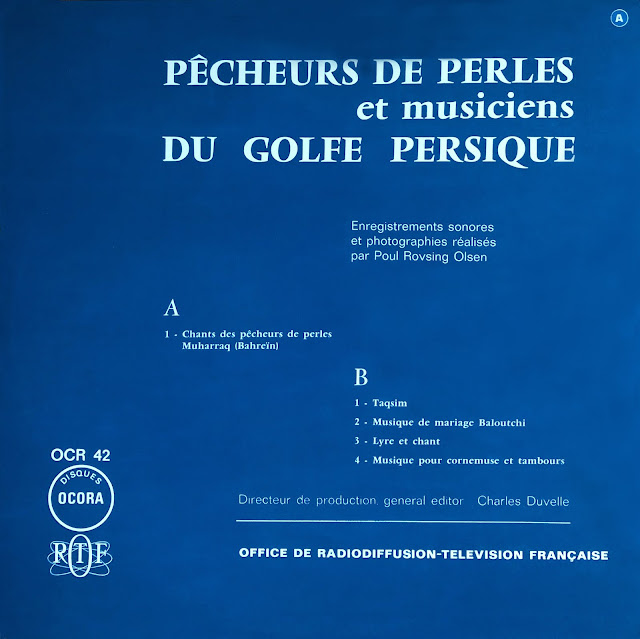BAHRAIN – UNITED ARAB EMIRATES
Pêcheurs de Perles et Musiciens du Golfe Persique – OCORA 42, recorded by Poul Rovsing Olsen, 1962-1963 (LP)
Pêcheurs de Perles et Musiciens du Golfe Persique – OCORA 42, recorded by Poul Rovsing Olsen, 1962-1963 (LP)

This precious LP, recorded in 1962-1963, offers a rare glimpse into the fascinating traditional music from Bahrain and Sharjah (United Arab Emirates) in the Persian Gulf (aka the Arabian Gulf).
Side A
features stunning side-long singing by pearl divers from Muharraq, Bahrain, who
have been diving for pearls for more than 4,000 years. By the early 1960’s,
when this recording was made, they had almost disappeared following the
competition of cultured pearls from Japan in the 1930s, the discovery of oil
and the area’s gradual modernization.
As pearl
diving was a physically exhausting and perilous job, pearl boats welcomed professional
naham lead singers onboard with
accompanying musicians playing drums and hand cymbals to encourage and sustain
the energy of the divers and their helpers. Nahams sang at top volume,
supported by percussion, and the crew responded in deep, low drones (similar to
vocal drones in Tibetan Buddhist music), exclamations, clapping, and whistling.
These extraordinary trance-like collective worksongs were played uninterrupted
from dawn to dusk.
Side B
showcases inspired and dense performances highlighting the region’s rich ethnic
and cultural diversity:
(B1) Salim Ahmed performing a Taqsim (maqam rast) on the oud lute, Manama (Bahrain);
(B2) Baluchi
wedding music featuring a surnai oboe
and tabl drum, Sharjah (UAE);
(B3) Kafur
Moubarek, lyre (or tanboura) and voice, interpreting a love poem, Manama
(Bahrain);
Kafur
Moubarek was a Sudanese Bahraini. “Nowadays the lyre is
rarely used, except by East Africans; lyres may be found in Saudi Arabia and
several sheikhdoms of the Arabian Gulf but the musicians who play them are
always Africans of Sudanese origin,” says Poul Rovsing Olsen in the liner notes. (see miniature below).
(B4) Rajab bin Khamis on droneless jirbe
bagpipe, and two tabl drums, Manama
(Bahrain).
Ce disque précieux,
enregistré en 1962-1963, offre un aperçu rare de la remarquable musique
traditionnelle de Bahreïn et de Sharjah (Émirats arabes unis) dans le golfe
Persique (ou golfe Arabique).
La Face A présente des
chants fascinants de plongeurs de perles de Muharraq (Bahreïn) qui pêchaient la
perle depuis plus de 4 000 ans. Au début des années 1960, lorsque cet
enregistrement fut réalisé, ils avaient presque disparu en raison de la
concurrence des perles de culture du Japon dans les années 1930, la découverte
de pétrole et de la modernisation progressive de la région.
Comme la pêche à la
perle était un travail particulièrement éprouvant et périlleux, les
bateaux-perles embarquaient des chanteurs professionnels naham, accompagnés de
musiciens jouant du tambour et des cymbales à main pour encourager et soutenir
l’énergie des plongeurs et de leurs assistants. Le naham chantait fort, soutenu
par des percussions, auquel l’équipage répondait par des bourdons profonds dans
l'extrême grave (rappelant les bourdons vocaux que l’on trouve dans la musique
bouddhiste tibétaine), des exclamations, des applaudissements et des
sifflements. Ces extraordinaires musiques collectives qui mènent à la transe étaient
jouées sans interruption de l'aube au crépuscule.
La face B présente des musiques
denses et inspirées qui reflètent la riche diversité ethnique et culturelle de
la région:
(B1) Salim Ahmed
exécutant un Taqsim (maqam rast) sur luth oud a cinq double cordes,
Manama (Bahreïn);
(B2) Musique de mariage Baloutchi
avec un hautbois surnai et un tambour tabl, Sharjah (Émirats
arabes unis);
(B3) Kafur Moubarek,
lyre (ou tanboura) et voix, interprétant un poème d'amour, Manama
(Bahreïn);
Kafur Moubarek était un
Bahreïni soudanais (voir miniature ci-dessous). « De nos jours, la lyre n’est
guère utilisée que par les Africains de l'Est ; on trouve des lyres en Arabie Saoudite
et dans plusieurs émirats du Golfe mais les musiciens qui s'en servent sont
toujours des Africains d'origine Soudanaise, » explique Poul Rovsing Olsen dans
les notes de l’album.
(B4) Rajab bin Khamis
jouant de la cornemuse jirbe sans bourdon, accompagné de deux tambours tabl,
Manama (Bahreïn).
Our other share of the region's music:
Abu Dhabi/Bahrain - Les Emirats du Golfe Arabique - Disques Alvarès C 471 here
“ONE OF THE MOST MUSICAL CULTURES OF ITS TIME?
The result, demographically and socially, of having professional musicians on so many pearling boats is remarkable. In 1907 J.G. Lorimer stated that Bahrain had 917 boats. If only half of the vessels had two musicians on board, in a population ca 70,000 that would indicate that 1.3 percent of Bahrainis were professional-level musicians. If we go back in time, the proportions are even greater. The Dutch explorer Carsten Niebuhr noted that by 1750 Kuwait actually had 800 pearl diving boats in a population of 10,000. If only 500 of the boats had one nahham, then 5 percent of the population of Kuwait were active musicians. This is a remarkable amount of people devoted to music in a lone community. Comparatively, in the US in 1910, not even a quarter of 1 percent were considered professional musicians (Lorimer 1907; Niehbur 1792, 127; Shamlan 2000, 53; US Census Bureau; U.S. Census of Population). The large proportion of Gulf musicians did not just have an impact on the seamen but also on the greater community. After four months on the pearling boats, musicians returned and were heard by, and influenced, the local residents. (…) Certainly, the Arabian Gulf is historically one of the most musical regions of the Peninsula.”*
*From the fascinating and richly-documented Music and Traditions of the Arabian Peninsula – Saudi Arabia, Kuwait, Bahrain, and Qatar by Lisa Urkevich, Routeledge, 2014.
Photograph below is from Mughal Paintings: Art and Stories by Sonya Rhie Quintanilla, Cleveland Museum of Art, 2016:
Lyre player (track B3), presumably Sudanese, Mughal painting, India, c. 1640-1660.









Teşekkürler...
ReplyDelete